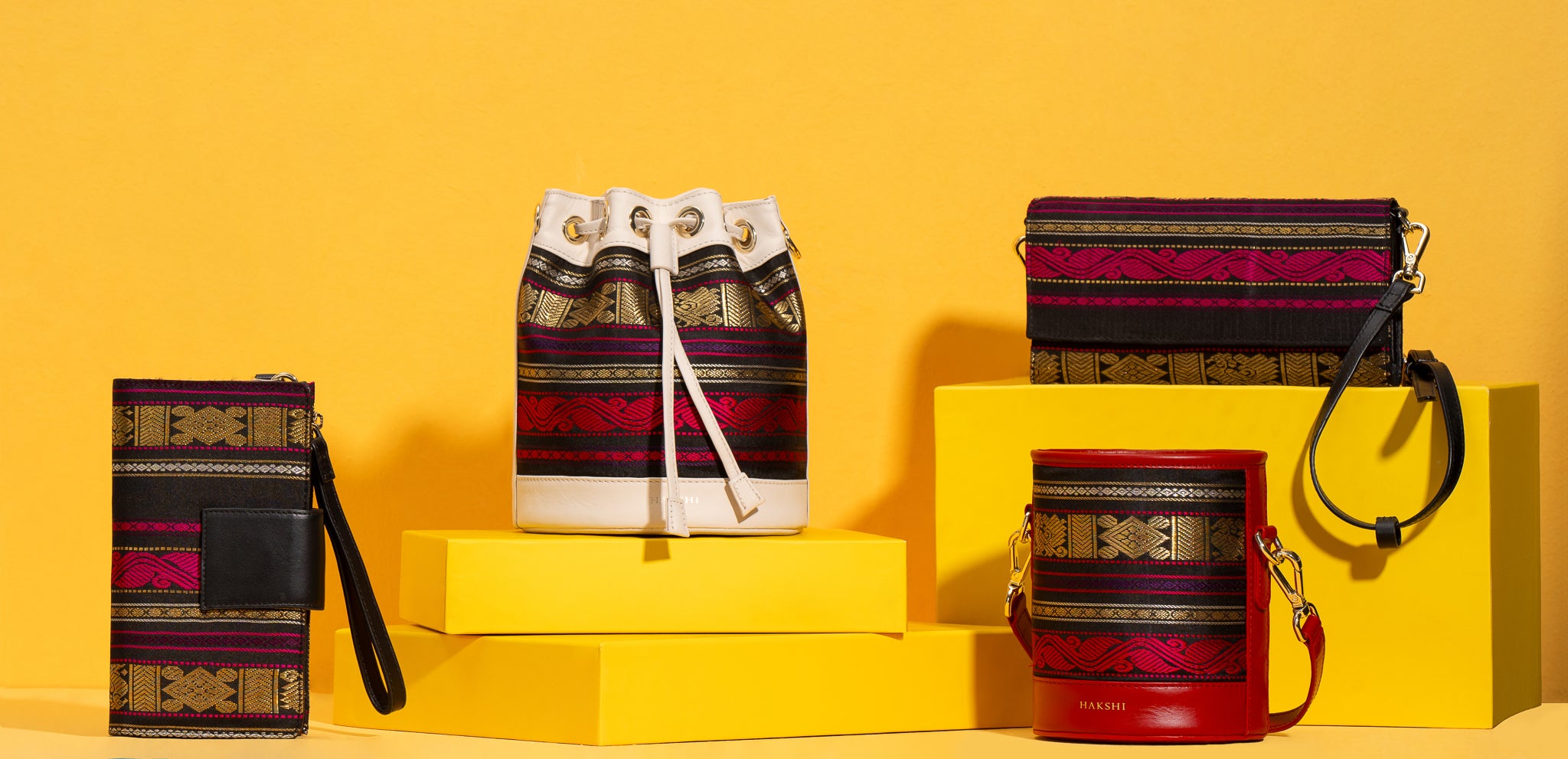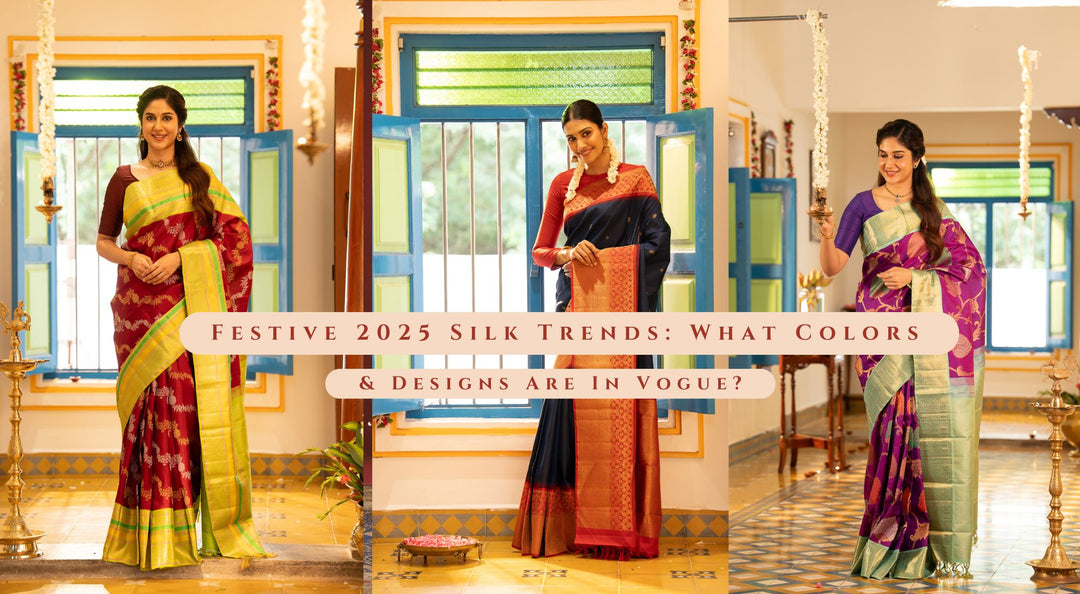Understanding the Types of Zari Used in a Kanchipuram Silk Saree
Introduction
The beauty of a Kanchipuram silk saree lies not only in its pure mulberry silk but also in the shimmering zari that gives it a divine touch. From temple borders to grand pallus, zari is what transforms silk into splendour. Each strand of zari tells a story of craftsmanship, culture, and heritage that has made Kanchipuram sarees world-famous.
But did you know that not all zari is the same? The type of zari used greatly influences the saree’s look, price, and longevity. In this detailed guide, let’s explore the types of zari used in pure Kanchipuram silk sarees, their making process, and how to identify the real ones.

What Is Zari? The Golden Thread of Tradition
Zari is a fine metallic thread traditionally made from gold or silver. In a Kanchipuram saree silk, it is used to outline motifs, highlight borders, and create intricate pallus. Historically, real gold was beaten into thin strips, wrapped around silk yarn, and woven into sarees meant for royalty and temple ceremonies.
Today, zari continues to represent opulence and grace the hallmark of every pure Kanchipuram silk saree.

The Art of Making Zari
Zari making is an intricate process perfected over centuries. It involves several skilled steps:
-
Preparing the Base Thread:
The core thread, often silk or cotton, forms the base. -
Wrapping Metal:
Thin strips of silver or copper are coated and tightly wound around the base thread. -
Gold Plating:
The wrapped threads are electroplated with gold to achieve a rich, lasting shine. -
Polishing:
The finished threads are polished and prepared for weaving. -
Weaving into Sarees:
The zari is woven into the silk, giving rise to borders, motifs, and grand pallus that make Kanchipuram silks so distinctive.
Types of Zari Used in Kanchipuram Silk Sarees
The zari used in silk saree kanchipuram weaving can be broadly classified into three types, each offering a unique aesthetic and price range.
1. Pure Zari (Real Zari or Gold Zari)
Pure zari is the traditional and most premium type used in pure Kanchipuram silk sarees. It’s made with real silver threads coated in gold and wrapped around silk.

Features
-
Composed of silver with gold plating
-
Long-lasting and luxurious
-
Has a heavy, royal texture
-
Tarnish-resistant when maintained properly
Why It’s Special
Pure zari sarees embody heritage weaving at its finest. They are treasured as heirlooms and are ideal for brides and temple wear. Every drape radiates timeless grandeur.
Explore Collection:
👉 Shop Pure Kanchipuram Silk Sarees
2.
Half-fine zari uses copper wire coated with gold instead of silver, making it more affordable while retaining a rich appearance.
Features
-
Copper core with gold plating
-
Lightweight and affordable
-
Similar visual appeal to pure zari
-
Requires moderate care
Why It’s Popular
Most modern Kanchipuram silk saree online collections feature half-fine zari as it combines affordability with traditional beauty. Perfect for festive wear and gifting.
Explore Collection:
3. Imitation Zari (Artificial Zari)
Imitation zari is made from metallic or polyester threads, offering a modern, lightweight alternative for fashion-forward sarees.
Features
-
Synthetic or metal blend threads
-
Budget-friendly
-
Not as durable as pure or half-fine zari
-
Shiny, modern finish
Why It’s Used
It allows experimentation with contemporary colors and motifs while keeping sarees lightweight and easy to drape.
Pure vs. Tested vs. Imitation Zari: A Quick Comparison
|
Feature |
Pure Zari |
Half-fine Zari |
Imitation Zari |
|
Material Composition |
Silver threads coated with real gold, wound around silk |
Copper threads coated with gold, wound around silk |
Metallic or polyester threads designed to mimic gold/silver |
|
Durability & Longevity |
Extremely durable; can last generations |
Moderate; may lose shine after several years |
Low; color may fade or peel |
|
Appearance & Shine |
Deep, rich golden sheen; highly lustrous |
Similar to pure zari; slightly lighter shine |
Shiny initially but can appear artificial |
|
Weight |
Heavy due to silver and gold content |
Moderate weight; easier to drape |
Very light; suitable for casual use |
|
Cost |
Premium, high-end pricing |
Affordable luxury; mid-range |
Budget-friendly; lowest price range |
|
Maintenance |
Requires careful storage, dry cleaning recommended |
Moderate care; avoid chemicals |
Minimal care; hand wash or gentle dry cleaning |
|
Ideal Usage |
Bridal, heirloom, ceremonial sarees |
Festivals, gifting, occasional events |
Casual, fashion-oriented, party wear |
|
Cultural Significance |
Heritage, prosperity, divine elegance |
Traditional beauty at affordable cost |
Fashion-focused; modern trends |
|
Visual Motifs |
Intricate temple, paisley, floral designs |
Similar but less dense motifs |
Contemporary or simplified motifs |
|
Certification |
Silk Mark + Zari authenticity certificate |
Sometimes includes Zari certificate |
Usually no certification |
|
Market Availability |
Limited; exclusive stores & Clio Silks |
Widely available |
Easily found in fashion saree collections |
How to Identify Genuine Zari in a Kanchipuram Silk Saree
When buying a Kanchipuram silk saree online, authenticity matters. Here’s how to check:
-
Silk Mark Certification:
Always buy sarees with the Silk Mark tag, ensuring genuine silk.
-
Zari Label:
Pure zari sarees often carry a separate zari authenticity certificate. -
Thread Test:
In pure zari, the core thread is silk; imitation zari uses polyester. -
Price Point:
Genuine zari sarees are always more expensive due to gold and silver content. -
Weight & Feel:
Pure zari sarees have a distinct weight and a soft, luxurious drape.
The Role of Zari in Kanchipuram Weaving
The zari defines the saree’s structure, borders, and motifs. Traditional designs such as rudraksha, mayil (peacock), mango, and temple patterns come alive because of zari detailing.
In sarees silk kanchipuram, zari is not just decorative it adds texture, shine, and symbolic meaning. The gleaming threads represent prosperity and auspiciousness, which is why kanchipuram silks are an essential part of South Indian weddings.

Zari Weaving Heritage: From Surat to Kanchipuram
While Kanchipuram remains the center for weaving, zari threads are often sourced from Surat and Salem cities known for fine metallic thread production. The partnership between zari makers and Kanchipuram weavers creates masterpieces that blend artistry, devotion, and skill.
This synergy ensures that every Kanchipuram silk saree continues to uphold the centuries-old legacy of Indian handloom craftsmanship.
Modern Innovations in Zari
Today’s designers are blending tradition with innovation in zari weaving:
-
Antique Zari: For a muted, vintage gold look
-
Rose Gold Zari: Adds a soft, feminine glow
-
Matte Zari: Perfect for subtle, contemporary sarees
-
Colored Zari: Introduces hues like copper, green, and red
-
Eco-Friendly Zari: Sustainable options made without harmful chemicals
These innovations ensure Kanchipuram silk sarees online stay relevant to both traditional buyers and modern fashion enthusiasts.

Caring for Zari Sarees
To preserve the brilliance of zari:
-
Store sarees in a muslin or cotton bag
-
Avoid direct sunlight or moisture
-
Do not use naphthalene balls
-
Always dry clean instead of washing
-
Refold sarees periodically to prevent zari breakage
With the right care, your pure Kanjivaram silk saree will remain timeless for decades.
Why Zari Makes Kanchipuram Sarees Unique
The zari in a Kanchipuram silk saree isn’t just about aesthetics, it represents heritage and devotion. Each gold thread weaves together stories of artisans, temples, and tradition. Whether you choose a pure zari bridal saree or a lightweight half-fine zari drape, every weave celebrates India’s cultural soul.
At Clio Silks, each saree is handpicked for its authenticity, craftsmanship, and beauty keeping alive the legacy of traditional silk weaving.

Conclusion
Zari is the soul of the Kanchipuram saree silk tradition. From real gold zari that adorned royal wardrobes to modern half-fine zari that brings luxury within reach each variant adds its charm. Understanding these types helps you choose the right saree for your occasion and budget.
When you invest in a pure Kanchipuram silk saree, you’re not just buying a piece of clothing; you’re preserving a timeless art form that continues to define Indian elegance.






Leave a comment